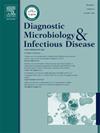Urinary leptospiral sphingomyelinases as diagnostic markers of leptospirosis in dengue patients co-infected with leptospirosis
IF 2.1
4区 医学
Q3 INFECTIOUS DISEASES
Diagnostic microbiology and infectious disease
Pub Date : 2024-12-06
DOI:10.1016/j.diagmicrobio.2024.116647
引用次数: 0
Abstract
The study aims to evaluate the diagnostic potential of pathogen-specific leptospiral sphingomyelinases, LipL32, LipL41, and HbpA in human patients with dengue-leptospirosis coinfection. Patients (n-86), upon clinical evaluation, were categorized into Group I (n-37; leptospirosis), Group II (n-39; dengue-leptospirosis coinfection), and Group III (n-10; negative for both dengue and leptospirosis). ELISA identified significant levels of the four leptospiral antigens in the urine of Group I and II, but not in Group III patients. Immunoblot analysis of the urinary proteins with specific antibodies identified the tissue-damaging true sphingomyelinases Sph2 and pore-forming SphH. Urinary leptospiral antigens identified patients with leptospirosis and with dengue-leptospirosis coinfection. Patients with renal damage and proteinuria showed high urinary excretion of anti-leptospiral antibodies, with markedly low values in the serum. Proteinuria resulted in the loss of the circulating proteins, reflected by the low levels of anti-leptospiral antibodies in serum, with urine showing albumin and high levels of anti-leptospiral antibodies.
IMPORTANCE: The study highlights the diagnostic potential of all four leptospiral antigens. Since early detection of urinary sphingomyelinases is possible, their diagnostic and prognostic potential can be evaluated on a larger sample size. Non-invasive, point-of-care diagnostic devices can be developed for use in endemic regions, particularly during monsoon seasons.
尿钩端螺旋体鞘磷脂酶作为登革热合并钩端螺旋体病患者钩端螺旋体病的诊断指标
本研究旨在评估病原体特异性钩端螺旋体鞘磷脂酶、LipL32、LipL41和HbpA在登革热-钩端螺旋体合并感染患者中的诊断潜力。患者(n-86)经临床评估分为I组(n-37;钩端螺旋体病),II组(n-39;登革热-钩端螺旋体病合并感染)和第三组(n-10;登革热和钩端螺旋体病均呈阴性)。ELISA检测到I组和II组患者的尿液中有显著水平的四种钩端螺旋体抗原,但在III组患者中没有。用特异性抗体对尿蛋白进行免疫印迹分析,鉴定出具有组织损伤作用的真鞘磷脂酶Sph2和造孔酶SphH。尿钩端螺旋体抗原鉴定出钩端螺旋体病和登革热-钩端螺旋体合并感染患者。肾损害和蛋白尿患者尿中抗钩端螺旋体抗体高,血清中抗体明显低。蛋白尿导致循环蛋白的损失,反映在血清中抗钩端螺旋体抗体水平低,尿液中显示白蛋白和高水平的抗钩端螺旋体抗体。重要性:该研究强调了所有四种钩端螺旋体抗原的诊断潜力。由于早期发现尿鞘磷脂酶是可能的,它们的诊断和预后潜力可以在更大的样本量上进行评估。可以开发非侵入性的即时诊断设备,用于流行地区,特别是在季风季节。
本文章由计算机程序翻译,如有差异,请以英文原文为准。
求助全文
约1分钟内获得全文
求助全文
来源期刊
CiteScore
5.30
自引率
3.40%
发文量
149
审稿时长
56 days
期刊介绍:
Diagnostic Microbiology and Infectious Disease keeps you informed of the latest developments in clinical microbiology and the diagnosis and treatment of infectious diseases. Packed with rigorously peer-reviewed articles and studies in bacteriology, immunology, immunoserology, infectious diseases, mycology, parasitology, and virology, the journal examines new procedures, unusual cases, controversial issues, and important new literature. Diagnostic Microbiology and Infectious Disease distinguished independent editorial board, consisting of experts from many medical specialties, ensures you extensive and authoritative coverage.

 求助内容:
求助内容: 应助结果提醒方式:
应助结果提醒方式:


